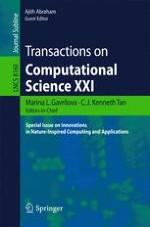2013 | Buch
Transactions on Computational Science XXI
Special Issue on Innovations in Nature-Inspired Computing and Applications
herausgegeben von: Marina L. Gavrilova, C. J. Kenneth Tan, Ajith Abraham
Verlag: Springer Berlin Heidelberg
Buchreihe : Lecture Notes in Computer Science
